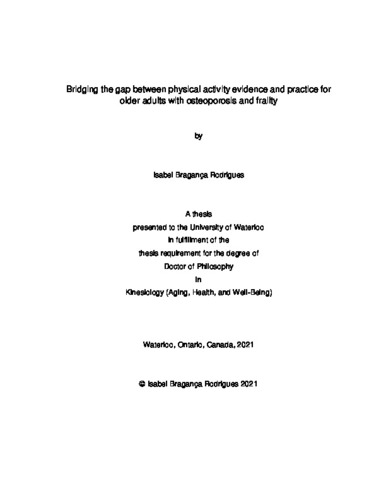| dc.description.abstract | Exercise prescriptions that include moderate or high intensity progressive, resistance training, and functional and balance training may improve physical functioning and disability outcomes and prevent falls in older adults with chronic conditions. For certain individuals, moderate or high impact exercises may also have benefits for bone health. While exercise recommendations may be well recognized by the scientific community, the translation of exercise guidelines in practice may receive little to no attention. This thesis includes three studies (five manuscripts) with an overarching objective to improve exercise participation among people with osteoporosis and frailty in practice. To accomplish this goal, we sought a knowledge translation strategy to bridge the gap between current knowledge in exercise science and practice, specifically focusing on people with osteoporosis and frailty. The Knowledge-to-Action Cycle was used to guide the development and to implement meaningful and effective interventions.
The objectives of the thesis were: 1) to summarize the evidence on the effects of impact exercises on falls, fractures, health-related quality of life, mortality, and physical functioning and disability in individuals 50 years and older at risk of fractures; 2) to understand perspectives on starting or continuing moderate or high impact exercises and resistance training in people with osteoporosis; and 3) to determine the feasibility of implementing a model to teach pre-frail and frail older adults balance and functional strength training in combination with consuming enough protein (MoveStrong).
The first study resulted in two systematic reviews: one on impact exercises and the other on walking and Nordic walking. The first systematic review revealed that there is limited evidence on the benefits of impact exercises on several health-related outcomes, although there is low certainty evidence that impact exercises alone or combined with resistance training may improve mobility and bone mineral density at the lumbar spine and femoral neck. The second review found a very limited number of studies on walking and Nordic walking in people with osteoporosis. Although most studies had a high risk of bias and of very low certainty, the evidence suggests that Nordic walking may improve mobility in older adults. There is insufficient data on the benefits of low, moderate, or high impact exercises on falls, fractures, and mortality in people with osteoporosis.
The second study was a qualitative study to understand perspectives on starting or continuing impact exercise and strength training. We used a qualitative description method and conducted semi-structured, one-on-one interviews with people living with osteoporosis. We generated three salient themes related to perspective on starting or continuing moderate or high impact exercise and strength training. Theme one identified that exercise terminology should be carefully selected since exercise terms may be interpreted literally and induce positive or negative perspectives about the activity or exercise. For example, impact exercises were perceived to be jolting, bursting, or jarring, whereas strength training was described as an activity that “strengthens”. As a result, participant’s literal interpretation of the exercise terminology may induce positive or negative attitudes that influence uptake of the activity. Theme two suggests that exercise programs should be delivered in a similar approach to other treatments and procedures in our medical system. There was a clear parallel in how participants would like exercise programs to be delivered versus how healthcare providers currently prescribe and monitor treatments and procedures in healthcare. Lastly, participants are strongly influenced by discussions with their healthcare provider or by conversations regarding management of osteoporosis with strangers over social media. Certain individuals had strong anti-medication views, which they read about over social media. As a result, to avoid pharmaceutical drugs, participants said they were willing to participate in moderate or high impact exercise or strength training.
In the third study, we conducted a pilot and feasibility randomized controlled trial to evaluate the MoveStrong program in areas that typically represent real-world practice. We determined feasibility by evaluating recruitment, retention, and adherence rates to the program. We also explored the effect of MoveStrong on secondary outcomes including body weight, gait speed, grip strength, fatigue levels, lower limb muscle strength, dynamic balance, health-related quality of life, and protein intake. We found the MoveStrong program was feasible in terms of recruitment and adherence but not retention. MoveStrong may improve some frailty outcomes including grip strength, lower limb muscle strength, and dynamic balance. Exploratory analyses of secondary outcomes found the program may improve gait speed, lower limb muscle strength, dynamic balance, and health-related quality of life index scores in older adults who are pre-frail or frail. We provide some suggestions to improve the implementation of MoveStrong for a larger trial including modifying some of the exercises, considering volunteer assistance, and employing recruitment strategies to target men and diverse groups. | en |

